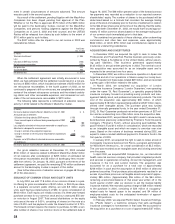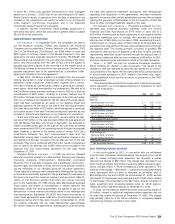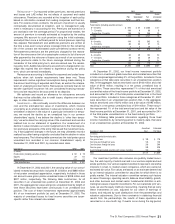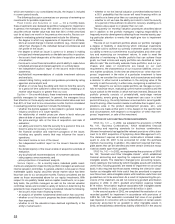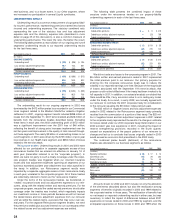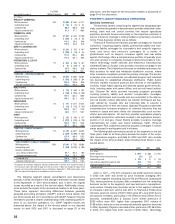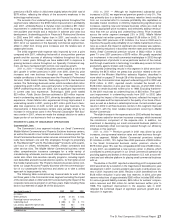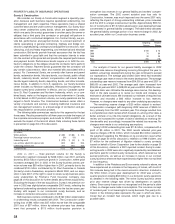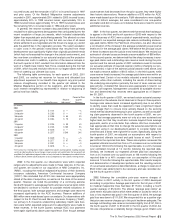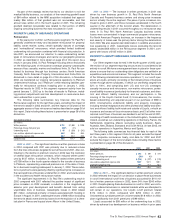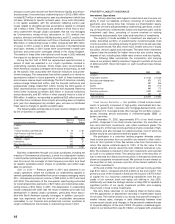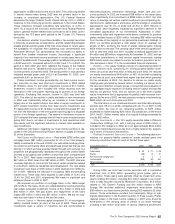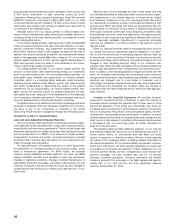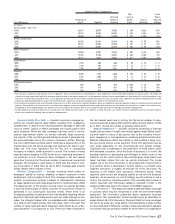Travelers 2002 Annual Report Download - page 40
Download and view the complete annual report
Please find page 40 of the 2002 Travelers annual report below. You can navigate through the pages in the report by either clicking on the pages listed below, or by using the keyword search tool below to find specific information within the annual report.
PROPERTY-LIABILITY INSURANCE OPERATIONS
Surety & Construction
We consider our Surety & Construction segment a specialty oper-
ation, because each business requires specialized underwriting, risk
management and claim expertise. These operations have a shared
customer base and are under common management. Our Surety busi-
ness center underwrites surety bonds, which are agreements under
which one party (the surety) guarantees to another party (the owner or
obligee) that a third party (the contractor or principal) will perform in
accordance with contractual obligations. For Contract Surety, we pro-
vide bid, performance and payment bonds, to a broad spectrum of
clients specializing in general contracting, highway and bridge con-
struction, asphalt paving, underground and pipeline construction, man-
ufacturing, civil and heavy engineering, and mechanical and electrical
construction. Bid bonds provide financial assurance that the bid has
been submitted in good faith and that the contractor intends to enter
into the contract at the price bid and provide the required performance
and payment bonds. Performance bonds require us to fulfill the con-
tractor’s obligations to the obligee should the contractor fail to perform
under the contract. Payment bonds guarantee that the contractor will
pay certain subcontractor, labor and material bills associated with a
project. For Commercial Surety, we currently offer license and permit
bonds, reclamation bonds, fiduciary bonds, court bonds, public official
bonds, indemnity bonds, workers’ compensation self-insurer bonds,
transfer agent indemnity bonds, depository bonds, and other miscella-
neous bonds. In addition to its U.S. operations, our Surety business
center includes our Mexican subsidiary, Afianzadora Insurgentes, the
largest surety bond underwriter in Mexico, and our Canadian opera-
tions St. Paul Guarantee and Northern Indemnity, which, on a com-
bined basis, make us the largest surety bond underwriter in Canada.
In total, based on 2001 premium volume, our surety operations are the
largest in North America. The Construction business center offers a
variety of products and services, including traditional insurance and
risk management solutions, to a broad range of contractors and par-
ties responsible for construction projects.
The following table summarizes results for this segment for the last
three years. Results presented for all three years exclude the impact of
the corporate reinsurance program, and results for 2002 and 2001 also
exclude the impact of the terrorist attack. Data including these factors
is presented on page 36 of this discussion.
Years Ended December 31 2002 2001 2000
($ in millions)
Written premiums $1,252 $1,006 $ 913
Percentage increase over prior year 24% 10%
Underwriting result $(212) $(52) $ 19
Loss and loss adjustment expense ratio 82.2 68.8 55.6
Underwriting expense ratio 35.0 35.9 40.0
Combined ratio 117.2 104.7 95.6
2002 vs. 2001 — Total premium volume for the Surety &
Construction segment increased by $246 million over 2001, primarily
driven by $153 million of premium growth in Construction, where price
increases averaged 30% in 2002. In the Surety business center, pre-
mium volume was $93 million higher than in 2001, primarily due to the
combined $100 million contributed by St. Paul Guarantee in Canada
(formerly London Guarantee), acquired in March 2002, and our acqui-
sition in late 2001 of the right to seek to renew surety business previ-
ously underwritten by Fireman’s Fund Insurance Company (see
page 28 of this discussion for further details about these acquisitions).
Excluding the impact of the two acquisitions, Surety’s net premium vol-
ume in 2002 was slightly below comparable 2001 levels, reflecting the
tightened underwriting standards instituted over the last two years, par-
ticularly with respect to our commercial surety business, and an
increase in domestic reinsurance costs in 2002.
Both business centers contributed to the $160 million deterioration
in underwriting results compared with 2001. The Construction under-
writing loss of $94 million was $37 million worse than the comparable
2001 loss of $57 million, driven by adverse prior-year loss develop-
ment that prompted a $113 million fourth-quarter provision to
38
strengthen loss reserves in our general liability and workers’ compen-
sation coverages. The 2002 current accident year loss ratio for
Construction, however, was much improved over the same 2001 ratio,
reflecting the impact of strong underwriting initiatives, price increases
and the shift to a larger-sized account profile. Approximately $93 mil-
lion of Construction’s $113 million adverse prior year development was
concentrated in general liability coverages. The table below allocates
the general liability coverage portion of our reserve charge in 2002, by
accident year, within our Construction business center.
2002
Beginning Reserve
Accident Year Reserve Charge
(In millions)
2001 $ 150 $13
2000 74 64
1999 90 35
Prior 255 (19)
Total $ 569 $93
Our analysis of trends for our general liability coverages in 2002
revealed case reserve strengthening occurring throughout the year. In
addition, actual loss development during the year continued to exceed
our expectations. The average paid closed claim trend had exceeded
the average case reserve trend in the recent development.The average
outstanding case reserve increased from $54,000 at year-end 2001 to
$66,000 at year-end 2002. The average paid claim increased from
$18,000 at year-end 2001 to $28,000 at year-end 2002.While the aver-
age paid claim was still below the average case reserve, this develop-
ment in the data caused us to revise our trends and increase our
estimate of ultimate losses.We increased our estimate of required loss
reserves and recorded a $93 million increase to loss reserves.
However, no changes were made to any other underlying assumptions.
The remaining reserve charge of $20 million related to workers’
compensation coverages (with beginning 2002 reserves of $363 mil-
lion), primarily from the 2001 accident year. This charge resulted from
a comprehensive claim review which focused on, among other data, a
better estimate of our life-time benefit obligations. As a result of this
review, we increased the number of claims identified as receiving life-
time benefits and, accordingly, increased the related loss reserves. No
changes were made to our underlying assumptions.
Surety’s 2002 underwriting loss was $118 million, compared with a
profit of $5 million in 2001. The 2002 results reflected prior-year
reserve charges of $104 million, which included $34 million related to
the judgment regarding the Petrobras oil rig construction (see further
details on page 30 of this discussion), related to a 1996 incident, and
$7 million for the settlement of litigation related to surety contracts
issued on behalf of Enron Corporation (see further details on page 30
of this discussion), related to a 2001 reported incident. Surety’s under-
writing results in 2002 were also negatively impacted by reinstatement
premiums paid for contract surety reinsurance, which reduced our net
earned premiums, as well as an increase in losses in our contract
surety business where we have experienced a higher than normal level
of loss frequency.
In addition to the Petrobras and Enron events referred to above, we
have experienced an increase in the frequency of losses, with much of
this increase being tied to the recent economic downturn. Included in
the $104 million of prior-year development for 2002 was a fourth-
quarter provision totaling $63 million in our domestic surety operations
as detailed in the following table. The entire Surety business center
prior year reserve charge was driven by development on specific
claims. Since surety losses are not recognized until the period a claim
is filed, no changes were made to assumptions.The insurance concept
of “accident year” is not meaningful to surety business.The yearly infor-
mation in the following table represents the year in which we deter-
mined that an incident had occurred, which might give rise to a
possible claim.


